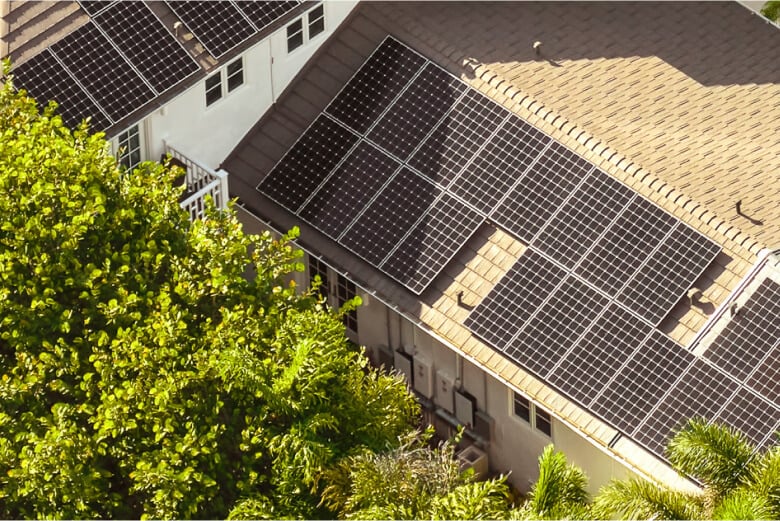
Australia’s solar sector delivered a strong September performance in the National Electricity Market (NEM) as the country entered spring, with combined solar PV generation reaching 3,933GWh—a 17.83% increase from August’s 3,338GWh.
The month marked a pivotal moment for renewable energy penetration, culminating in a record-breaking 78.6% instantaneous renewable energy share on 22 September.
Try Premium for just $1
- Full premium access for the first month at only $1
- Converts to an annual rate after 30 days unless cancelled
- Cancel anytime during the trial period
Premium Benefits
- Expert industry analysis and interviews
- Digital access to PV Tech Power journal
- Exclusive event discounts
Or get the full Premium subscription right away
Or continue reading this article for free
Rooftop solar PV rises by 28% month-on-month
Distributed rooftop systems drove September’s impressive performance, generating 2,614GWh throughout the month—a 28% increase from August’s 2,042GWh.
This growth becomes more significant when viewed against the previous year’s baseline, with rooftop generation climbing 13.55% above September 2024’s 2,302GWh output.
The distributed solar surge reflects the technology’s continued expansion across Australian households and businesses. Rooftop installations now contribute 14.9% of total NEM electricity generation. Utility-scale solar maintained steady momentum, finishing September with 1,319GWh generated compared to August’s 1,296GWh.
As detailed in the chart above, sourced from Open Electricity (formerly OpenNEM), both solar generation types experienced steady growth as seasonal conditions improved and daylight hours extended across the NEM.
While the 23GWh monthly increase appears modest, it represents solid 16.01% year-on-year growth from September 2024’s 1,137GWh baseline.
Analysis reveals rooftop systems consistently outperformed utility-scale installations throughout September, averaging 86.4GWh daily compared to 44.3GWh for utility-scale projects. This performance differential highlights distributed generation’s growing dominance in Australia’s solar landscape.
You can explore August’s solar generation performance in our previous NEM data spotlight, with all entries available to PV Tech Premium subscribers.
Record-breaking renewable energy penetration
September delivered multiple renewable energy milestones, with 22 September achieving the NEM’s highest instantaneous renewable energy share of 78.6%, surpassing the previous day’s 77.9% record.
Rooftop solar installations dominated these historic moments, contributing over 43% of total grid demand during the peak renewable energy period, while utility-scale solar added 12.1% and wind generation provided 19.8%.
The record-setting day saw rooftop solar deliver 94GWh to the NEM, though this wasn’t the month’s peak performance. On 18 September, rooftop systems reached their highest daily output of 104GWh, demonstrating the technology’s capacity during optimal spring conditions.
Conversely, 10 September marked the month’s weakest solar performance, with rooftop systems generating just 57GWh while utility-scale installations contributed only 10GWh.
Despite this low point, rooftop solar’s minimum generation exceeded utility-scale systems’ median performance of 44GWh, indicating robust baseline performance across distributed installations.
Pricing volatility exposes market challenges
September’s generation achievements came alongside severe pricing volatility that exposed structural challenges in Australia’s evolving electricity market.
Both scales of solar deployment experienced extreme value swings, reaching peaks near AU$85/MWh (US$56.22/MWh) before plunging into deeply negative territory.
Rooftop systems faced negative pricing on 56.7% of September days compared to 46.7% for utility-scale installations. Perhaps more ominously, rooftop solar hit a low of -AU$34.23/MWh—nearly double utility-scale’s -AU$18.22/MWh minimum.
These pricing challenges translated into significant economic disparities. Throughout September, utility-scale solar averaged AU$4.93/MWh compared to rooftop solar’s AU$1.41/MWh, generating three-and-a-half times more total monthly value despite similar peak pricing potential.
The extreme volatility, with coefficients of variation exceeding 400% for both technologies, signals market stress as renewable energy penetration increases.
Rooftop solar faced particularly severe price swings with a standard deviation of AU$25.32/MWh compared to utility-scale’s AU$21.85/MWh.
Renewables provide 7.5TWh for the NEM
September 2025 marked a watershed moment for Australia’s NEM, with renewable energy sources delivering over 7.5TWh of generation and pushing clean energy’s share past the 50% threshold.
Solar technologies dominated the renewable energy landscape, with their combined 3,933GWh representing 22.4% of total NEM generation—positioning solar as the second-largest generation source after black coal.
Wind energy remained the largest single renewable energy contributor, delivering 3,388GWh (19.3% of total generation) while providing crucial baseload renewable energy capacity that complements solar’s daytime profile.
Despite renewable energy’s surge, coal-fired generation retained its overall dominance, with black coal contributing 6,290GWh (35.8%) and brown coal adding 1,977GWh (11.3%).
Combined coal technologies accounted for 47.1% of total generation, representing a continued decline from historical levels but highlighting the gradual transition.
Battery storage systems discharged 151GWh during September, demonstrating growing grid-scale storage deployment across the NEM. While representing just 0.9% of total generation, the technology’s rapid expansion suggests increasing importance for managing renewable energy integration challenges.






